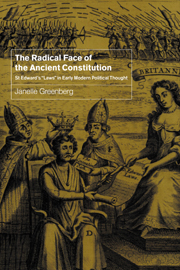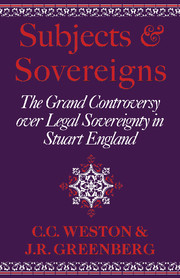32 results
John Phillip Reid, The Ancient Constitution and the Origins of Anglo-American Liberty, DeKalb: Northern Illinois University Press, 2005. Pp. 180. $32.00 (ISBN 0-87580-342-3).
-
- Journal:
- Law and History Review / Volume 25 / Issue 3 / Fall 2007
- Published online by Cambridge University Press:
- 18 August 2010, pp. 653-654
- Print publication:
- Fall 2007
-
- Article
- Export citation
Rachel Weil. Political Passions: Gender, Family and Political Argument in England 1680–1714. (Politics, Culture and Society in Early Modern Britain.) Manchester: Manchester University Press; dist. by St. Martin's Press, New York, N.Y. 1999. Pp. x, 262. $79.95. ISBN 0-7190-5622-5.
-
- Article
- Export citation
Acknowledgments
-
- Book:
- The Radical Face of the Ancient Constitution
- Published online:
- 29 August 2009
- Print publication:
- 26 February 2001, pp ix-xii
-
- Chapter
- Export citation
6 - “That noble transcript of the original contract, the Confessor's laws”: the radical ancient constitution in the late Stuart period
-
- Book:
- The Radical Face of the Ancient Constitution
- Published online:
- 29 August 2009
- Print publication:
- 26 February 2001, pp 243-296
-
- Chapter
- Export citation
3 - “Divers and sundry ancient histories and chronicles”: the articulation of the ancient constitution in the Tudor period
-
- Book:
- The Radical Face of the Ancient Constitution
- Published online:
- 29 August 2009
- Print publication:
- 26 February 2001, pp 79-115
-
- Chapter
- Export citation
Bibliography
-
- Book:
- The Radical Face of the Ancient Constitution
- Published online:
- 29 August 2009
- Print publication:
- 26 February 2001, pp 297-334
-
- Chapter
- Export citation
5 - “You shall be king while you rule well”: the radical ancient constitution in the civil wars and interregnum
-
- Book:
- The Radical Face of the Ancient Constitution
- Published online:
- 29 August 2009
- Print publication:
- 26 February 2001, pp 182-242
-
- Chapter
- Export citation
Frontmatter
-
- Book:
- The Radical Face of the Ancient Constitution
- Published online:
- 29 August 2009
- Print publication:
- 26 February 2001, pp i-vi
-
- Chapter
- Export citation
2 - “Those most noble and equitable laws of St. Edward”: from the cult of the Confessor to the cult of the Confessor's laws
-
- Book:
- The Radical Face of the Ancient Constitution
- Published online:
- 29 August 2009
- Print publication:
- 26 February 2001, pp 36-78
-
- Chapter
- Export citation
4 - “By lex terrae is meant the laws of St. Edward the Confessor”: the footprints of the Saxons in the early seventeenth century
-
- Book:
- The Radical Face of the Ancient Constitution
- Published online:
- 29 August 2009
- Print publication:
- 26 February 2001, pp 116-181
-
- Chapter
- Export citation
1 - Hagiography and historiography: the long shadow of Edward the Confessor
-
- Book:
- The Radical Face of the Ancient Constitution
- Published online:
- 29 August 2009
- Print publication:
- 26 February 2001, pp 1-35
-
- Chapter
- Export citation

The Radical Face of the Ancient Constitution
- St Edward's 'Laws' in Early Modern Political Thought
-
- Published online:
- 29 August 2009
- Print publication:
- 26 February 2001
Index
-
- Book:
- The Radical Face of the Ancient Constitution
- Published online:
- 29 August 2009
- Print publication:
- 26 February 2001, pp 335-343
-
- Chapter
- Export citation
Contents
-
- Book:
- The Radical Face of the Ancient Constitution
- Published online:
- 29 August 2009
- Print publication:
- 26 February 2001, pp vii-viii
-
- Chapter
- Export citation
7 - Co-ordination and coevality in exclusion literature
-
- Book:
- Subjects and Sovereigns
- Published online:
- 08 October 2009
- Print publication:
- 29 January 1981, pp 182-221
-
- Chapter
- Export citation

Subjects and Sovereigns
- The Grand Controversy over Legal Sovereignty in Stuart England
-
- Published online:
- 08 October 2009
- Print publication:
- 29 January 1981
5 - The curious case of William Prynne
-
- Book:
- Subjects and Sovereigns
- Published online:
- 08 October 2009
- Print publication:
- 29 January 1981, pp 124-148
-
- Chapter
- Export citation
Frontmatter
-
- Book:
- Subjects and Sovereigns
- Published online:
- 08 October 2009
- Print publication:
- 29 January 1981, pp i-iv
-
- Chapter
- Export citation
Notes
-
- Book:
- Subjects and Sovereigns
- Published online:
- 08 October 2009
- Print publication:
- 29 January 1981, pp 267-378
-
- Chapter
- Export citation



